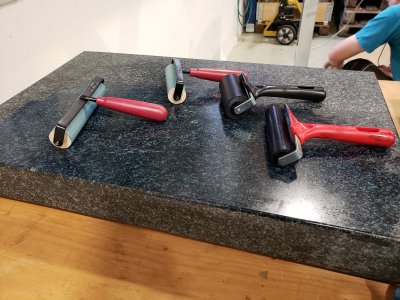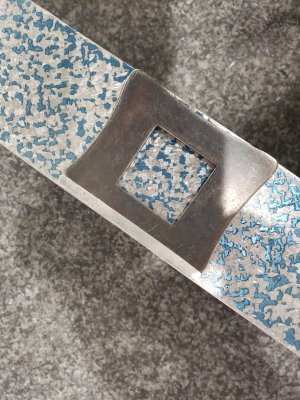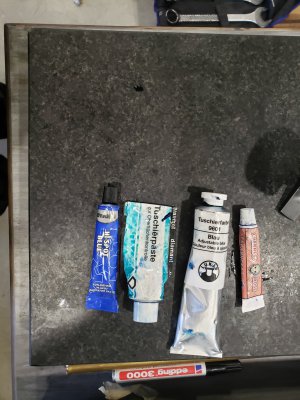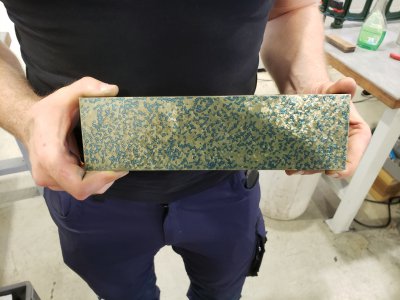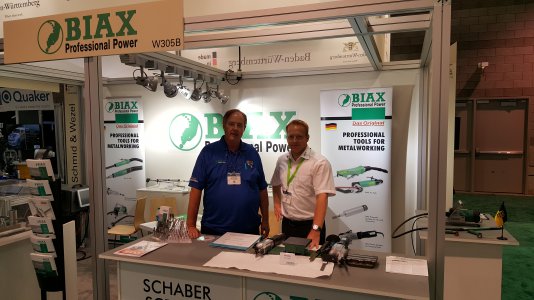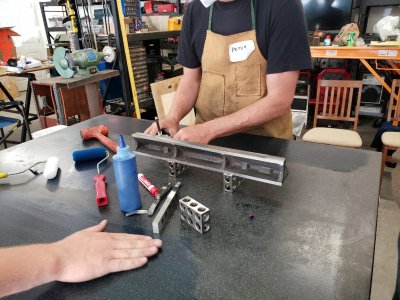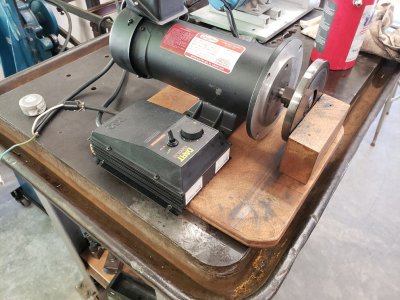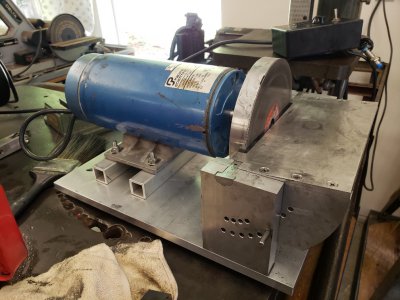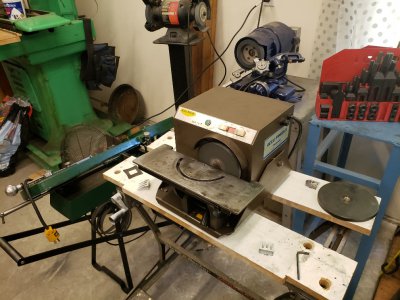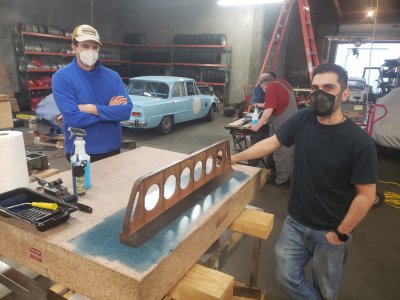- Joined
- Mar 26, 2018
- Messages
- 2,724
A newbie just barely getting his feet wet here...
Picked up a copy of Machine Tool Reconditioning, watched about every scraping video I could find on Youtube, bought some spotting dyes (canode and hi-spot), bought a 20mm Sandvik hand scraper, and I am currently building a slow speed diamond lapper to sharpen the blade.
Couple of random questions that have come up already:
1) My Sandvik scraper has a seemingly wide radius which has been giving me some trouble. My accuracy for where the cutting occurs across the width of the blade is very poor and I seem to shoot left and right of my high points with no discernable roll of the scraper. I read online that the factory provides 150mm radius as the default as they don't know what radius people will want to use. Is my frustration normal? I need to finish building the slow speed grinder and then I should be able to put a new radius on the blade.
2) What blade radius is appropriate for general work on small machines by a beginner? I have read 60 or 75mm, but don't know what is appropriate.
3) I don't yet have a piece of cast iron to work with so I have been practicing on a rusty V block. Pretty sure it is steel but soft enough to get a good bite even with a dull file. When I try to scrape it, I find the blade likes to bite, but not let me scrape forward. It just catches in the material and leaves a little flat line. If I push harder it will scrape, but taking off a wider swath of material than I want. Is this a function of the wide scraper blade, the material, or both? Is there a different grind for scraping steel?
4) I have read about the depth of the zones between high points is important for oil retention and too shallow is undesirable. I feel like the entirety of my scraped surface has very little texture. It is very flat, not necessarily in the sense of the "trueness" of the surface, but rather the scraping texture. I have nothing to compare against, but I feel like I am unable to develop the depth of texture required. Again, is this a function of the overly wide scraper blade?
5) I've used hi-spot blue for quite a while and have a good feel for how to develop a thin film on my surface plate. I can get decent spotting this way. The canode blue seems much tackier and I am having trouble getting anything but the thickest film. Any tips? I ordered a rubber brayer, but it has not yet arrived.
6) Are there good substitutes for red lead as a contrast medium? I don't really like the idea of anything lead in the shop, especially with pets and it being my house. Dapra was sold out of canode yellow when I ordered, but I did get some red. Is there another source for the canode inks besides Dapra?
7) I am having a much harder time seeing my spotting on this steel practice part than I was when I was scraping in some bearing blocks on my steam engine a few weeks ago. Those were cast iron. Something with the extra reflectivity of steel is making it hard to see. Any tips?
8) I might have a source of a 12x18 cast iron surface plate and an 18" cast iron parallel. Would these be good projects to start practicing on?
9) After those, I'd like to do a straightedge. my needs are to do a small mill and a 12" lathe cross slide. A 12" straight edge would be plenty long enough to do everything on both machines except the mill column and table. The column is roughly 18" of dovetails and the table is roughly 24". What would be right size straightedge casting to buy? I'd like to keep it as small as possible, both to help with cost and the difficulty of rough machining it (I only have small machines not capable of roughing the castings, so I'd need to make a friend).
10) Is there any good material on the technique for flaking? I have found nothing more than perhaps a 15 second clip of Abom79 doing a draw stroke with a dead blow mallet at one of Rich's scraping classes, but with zero explanation. I have no immediate need to figure this out, but I am curious.
11) I watched Robin Renzetti's video on Moore pattern scraping. Is there any particular benefit to doing it this way? Should I be developing the muscle memory for that? I'm finding it nearly impossible to form the crescents without digging the corners, but I suspect that is also a function of the overly large radius on the scraper blade.
12) Is there an appropriate corner treatment for the scraper blade? Out of the box, the Sandvik insert is sharp all the way to the corner. Should this be blunted?
13) I do not own precision ground flat stones. I do have a cheap fine india stone that I have sanded flat relative to my surface plate (abuse I know...). Is this acceptable for the time being, or are the PFG's a requirement? They aren't cheap and I feel like scraping has turned into $100 here, $100 there, $100 everywhere.
14) I have not found a source for the little lapped steel scrapers block used to bridge high points during measuring. Anyone know where to find one? I don't have a shop full of nice flat ground stuff, so I'm coming up short with anything to substitute.
That ended up being a few more than a couple questions, but I want to say thinks in advance for any answers.
Mike
Picked up a copy of Machine Tool Reconditioning, watched about every scraping video I could find on Youtube, bought some spotting dyes (canode and hi-spot), bought a 20mm Sandvik hand scraper, and I am currently building a slow speed diamond lapper to sharpen the blade.
Couple of random questions that have come up already:
1) My Sandvik scraper has a seemingly wide radius which has been giving me some trouble. My accuracy for where the cutting occurs across the width of the blade is very poor and I seem to shoot left and right of my high points with no discernable roll of the scraper. I read online that the factory provides 150mm radius as the default as they don't know what radius people will want to use. Is my frustration normal? I need to finish building the slow speed grinder and then I should be able to put a new radius on the blade.
2) What blade radius is appropriate for general work on small machines by a beginner? I have read 60 or 75mm, but don't know what is appropriate.
3) I don't yet have a piece of cast iron to work with so I have been practicing on a rusty V block. Pretty sure it is steel but soft enough to get a good bite even with a dull file. When I try to scrape it, I find the blade likes to bite, but not let me scrape forward. It just catches in the material and leaves a little flat line. If I push harder it will scrape, but taking off a wider swath of material than I want. Is this a function of the wide scraper blade, the material, or both? Is there a different grind for scraping steel?
4) I have read about the depth of the zones between high points is important for oil retention and too shallow is undesirable. I feel like the entirety of my scraped surface has very little texture. It is very flat, not necessarily in the sense of the "trueness" of the surface, but rather the scraping texture. I have nothing to compare against, but I feel like I am unable to develop the depth of texture required. Again, is this a function of the overly wide scraper blade?
5) I've used hi-spot blue for quite a while and have a good feel for how to develop a thin film on my surface plate. I can get decent spotting this way. The canode blue seems much tackier and I am having trouble getting anything but the thickest film. Any tips? I ordered a rubber brayer, but it has not yet arrived.
6) Are there good substitutes for red lead as a contrast medium? I don't really like the idea of anything lead in the shop, especially with pets and it being my house. Dapra was sold out of canode yellow when I ordered, but I did get some red. Is there another source for the canode inks besides Dapra?
7) I am having a much harder time seeing my spotting on this steel practice part than I was when I was scraping in some bearing blocks on my steam engine a few weeks ago. Those were cast iron. Something with the extra reflectivity of steel is making it hard to see. Any tips?
8) I might have a source of a 12x18 cast iron surface plate and an 18" cast iron parallel. Would these be good projects to start practicing on?
9) After those, I'd like to do a straightedge. my needs are to do a small mill and a 12" lathe cross slide. A 12" straight edge would be plenty long enough to do everything on both machines except the mill column and table. The column is roughly 18" of dovetails and the table is roughly 24". What would be right size straightedge casting to buy? I'd like to keep it as small as possible, both to help with cost and the difficulty of rough machining it (I only have small machines not capable of roughing the castings, so I'd need to make a friend).
10) Is there any good material on the technique for flaking? I have found nothing more than perhaps a 15 second clip of Abom79 doing a draw stroke with a dead blow mallet at one of Rich's scraping classes, but with zero explanation. I have no immediate need to figure this out, but I am curious.
11) I watched Robin Renzetti's video on Moore pattern scraping. Is there any particular benefit to doing it this way? Should I be developing the muscle memory for that? I'm finding it nearly impossible to form the crescents without digging the corners, but I suspect that is also a function of the overly large radius on the scraper blade.
12) Is there an appropriate corner treatment for the scraper blade? Out of the box, the Sandvik insert is sharp all the way to the corner. Should this be blunted?
13) I do not own precision ground flat stones. I do have a cheap fine india stone that I have sanded flat relative to my surface plate (abuse I know...). Is this acceptable for the time being, or are the PFG's a requirement? They aren't cheap and I feel like scraping has turned into $100 here, $100 there, $100 everywhere.
14) I have not found a source for the little lapped steel scrapers block used to bridge high points during measuring. Anyone know where to find one? I don't have a shop full of nice flat ground stuff, so I'm coming up short with anything to substitute.
That ended up being a few more than a couple questions, but I want to say thinks in advance for any answers.
Mike
Last edited:



